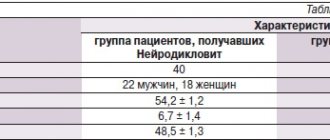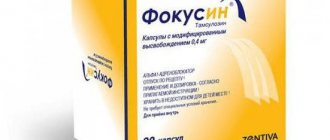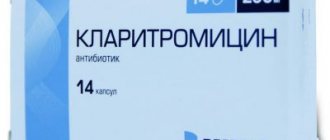Compound
| Modified-release capsules | 1 caps. |
| active substance: | |
| tamsulosin hydrochloride | 0.4 mg |
| excipients: methacrylic acid and ethyl acrylate copolymer [1:1] [30% dispersion]* - 74.9 (in solid form), MCC - 257.1 mg; dibutyl sebacate - 8.4 mg; polysorbate 80 - 0.5 mg; colloidal silicon dioxide - 3.7 mg; talc - 0.3 mg | |
| capsule shell: azorubine dye - 0.2%; patented blue dye - 0.12%; gelatin - up to 100% | |
| *For one capsule, a 30% dispersion of methacrylic acid and ethacrylate copolymer [1:1] is used in an amount of 249.67 mg, which corresponds to 74.9 mg in solid form |
Focusina price
The average price of Focusin in Russia is:
- 470-500 rubles per pack of 30 capsules;
- 1070-1200 rubles per pack of 90 capsules.
In Ukraine, the drug can be purchased at the price:
- 150-170 hryvnia for a pack of 30 capsules;
- 340-400 rubles per pack of 90 capsules.
- Online pharmacies in RussiaRussia
- Online pharmacies in UkraineUkraine
- Online pharmacies in KazakhstanKazakhstan
ZdravCity
- Focusin capsules with mod.
release 0.4 mg 30 pcs. Zentiva a.s./Saneka Pharmaceuticals a.s. RUR 478 order - Focusin capsules with mod. release 0.4 mg 90 pcs. Zentiva a.s./Saneka Pharmaceuticals a.s.
RUB 1,056 order
Pharmacy Dialogue
- Focusin (caps. 0.4 mg No. 30) Saneca
450 rub. order
- Focusin (caps. 0.4 mg No. 90) Saneca
RUB 1,027 order
- Focusin (caps. 0.4 mg No. 30)Zentiva
476 rub. order
show more
Pharmacy24
- Focusin 0.4 mg N30 capsules AT "Saneka Pharmaceuticals", Slovak Republic/Zentiva LLC, Czech Republic
111 UAH.order - Fokusin 0.4 mg No. 90 capsules LLC Zentiva, Czech Republic/AT "Saneka Pharmaceuticals", Slovak Republic
315 UAH. order
PaniPharmacy
- Focusin capsule Focusin capsules. 0.4 mg No. 90, Saneca Pharmaceuticals
303 UAH. order
- Focusin capsule Focusin capsules. 0.4 mg No. 30, Saneca Pharmaceuticals
132 UAH order
show more
Pharmacodynamics
Tamsulosin selectively and competitively blocks postsynaptic α1A-adrenergic receptors of the smooth muscles of the prostate gland, bladder neck and prostatic urethra and α1D-adrenergic receptors of the bladder, which leads to a decrease in the tone of the smooth muscles of the prostate gland, bladder neck and prostatic urethra, improving detrusor function and reducing symptoms of obstruction and irritation associated with benign prostatic hyperplasia.
As a rule, the therapeutic effect develops 2 weeks after starting the drug, although in some patients a decrease in the severity of symptoms is noted after taking the first dose.
The ability of tamsulosin to act on α1A-adrenergic receptors is 20 times greater than its ability to act on α1D-adrenergic receptors of vascular smooth muscle. Due to such high selectivity, the drug does not cause any clinically significant decrease in systemic blood pressure in both patients with arterial hypertension and in patients with normal baseline blood pressure.
Reviews about Focusin
Many men with prostatitis or prostate adenoma are forced to take tamsulosin .
Analyzing patient reviews of Focusin, we can conclude that most of them like this drug much more than Omnic , one of its most frequently prescribed analogues.
Reviews on forums indicate that when choosing Focusin or Omnic , many prefer the first, since it is much less likely to provoke such an unpleasant phenomenon as retrograde ejaculation .
Moreover, almost all patients note a noticeable positive effect from its use: urination does not cause such problems as before the course of treatment, and the imperative urge to urinate disappears.
For some of them, the most effective is the scheme according to which Fokusin for prostatitis or prostate adenoma is prescribed after treatment with antibiotics .
Pharmacokinetics
Suction. After oral administration, tamsulosin is quickly and almost completely absorbed from the gastrointestinal tract, its bioavailability is almost 100%. After a single dose of Fokusin® orally at a dose of 400 mcg, the Cmax of the active substance in plasma is achieved after 6 hours.
Distribution. After 5 days of course administration, the Cmax value of the active substance in the blood plasma is 60–70% higher than Cmax after a single dose. Plasma protein binding - 99%. Vd of tamsulosin is insignificant (approximately 0.2 l/kg).
Metabolism. Tamsulosin does not undergo the first pass effect and is slowly biotransformed in the liver to form pharmacologically active metabolites that retain high selectivity for α-adrenergic receptors. Most of the active substance is present in the blood unchanged.
Excretion. Tamsulosin is excreted by the kidneys, 9% of the dose is excreted unchanged. T1/2 of tamsulosin with a single dose is 10 hours, after multiple doses - 13 hours, final - 22 hours.
Overdose of the drug Focusin, symptoms and treatment
There have been no reports of cases of acute drug overdose. Theoretically, the development of acute hypotension is possible, requiring measures to maintain the function of the cardiovascular system. Treatment: cardiotropic therapy, parenteral administration of volume-substituting solutions, and, if necessary, vasoconstrictor drugs. Adjuvant therapy and monitoring of renal function should be carried out. The use of hemodialysis is ineffective due to the high degree of binding of the drug to plasma proteins. In order to reduce the absorption of the drug, vomiting should be induced, gastric lavage should be performed, and the use of activated charcoal or an osmotic laxative is indicated.
Contraindications
hypersensitivity to the components of the drug;
orthostatic hypotension (including history);
severe liver failure;
age under 18 years (efficacy and safety have not been established).
With caution: chronic renal failure (decrease in creatinine Cl below 10 ml/min); arterial hypotension (including orthostatic); planned cataract surgery; combined use with potent or moderately active inhibitors of the CYP3A4 isoenzyme (for example, ketoconazole, voriconazole).
Side effects
The frequency of adverse reactions is presented in accordance with the Medical Dictionary of Regulatory Activities (MedDRA) classification: very often (>10%); often (≥1, <10%); uncommon: (≥0.1, <1%); rare (≥0.01 <0.1%); very rare (<0.01%); frequency is unknown (it is not possible to determine the frequency of occurrence from the available data).
From the immune system: very rarely - hypersensitivity reaction.
From the nervous system: often - dizziness; infrequently - headache; rarely - syncope; frequency unknown - sleep disturbance (drowsiness or insomnia).
On the part of the organ of vision: frequency unknown - blurred vision, blurred vision.
From the heart: infrequently - palpitations; frequency unknown - tachycardia.
From the side of blood vessels: infrequently - orthostatic hypotension.
From the respiratory system, chest and mediastinal organs: infrequently - rhinitis; frequency unknown - nosebleeds.
From the gastrointestinal tract: rarely - nausea, vomiting, constipation or diarrhea.
From the skin and subcutaneous tissues: infrequently - skin rash, itching, urticaria; rarely - angioedema; very rarely - Stevens-Johnson syndrome; frequency unknown - erythema multiforme, exfoliative dermatitis.
From the genital organs and mammary gland: very rarely - priapism; frequency unknown - ejaculation disorders, incl. retrograde ejaculation, decreased libido.
General disorders and disorders at the injection site: uncommon - asthenic syndrome; frequency unknown - back pain, chest pain, dry mouth.
Fokusin's analogs
Level 4 ATX code matches:
Dalfaz
Sonirid Duo
Setegis
Terazosin
Sonizin
Omnik Okas
Omnic
Proflosin
Urorek
Tamsulosin
Adenorm
Omics
Fokusin analogues, which are usually understood as drugs that have the same international nonproprietary name or are equally classified in accordance with the standards of the international ATC system, are:
- Adenorm;
- Bazetam;
- Omics;
- Omnic;
- Omnimax;
- Ranoprost;
- Tamex;
- Tamsol;
- Tamsonic;
- Tamsulosin;
- Taniz;
- Tulosin;
- Urofrin;
- Flosin.
Interaction
Concomitant use of tamsulosin with other α1-blockers may lead to a decrease in blood pressure.
Diclofenac and indirect anticoagulants (warfarin) slightly increase the rate of elimination of tamsulosin.
Cimetidine increases the concentration of tamsulosin in plasma, and furosemide reduces it (has no significant clinical significance).
When tamsulosin was co-administered with atenolol, enalapril or theophylline, there were no signs of drug interaction.
In vitro, the administration of diazepam, propranolol, trichlormethiazide, chlormadinone, amitriptyline, diclofenac, glibenclamide, simvastatin and warfarin did not lead to a change in the free fraction of tamsulosin in the blood plasma. Tamsulosin also had no effect on the free fractions of diazepam, propranolol, trichlormethiazide and chlormadinone.
Concomitant use of tamsulosin and potent inhibitors of the CYP3A4 isoenzyme may cause increased systemic exposure to tamsulosin. Co-administration of tamsulosin with ketoconazole (a potent inhibitor of the CYP3A4 isoenzyme) led to an increase in the AUC and Cmax of tamsulosin by 2.8 and 2.2 times, respectively. Tamsulosin should not be used in combination with potent inhibitors of the CYP3A4 isoenzyme in patients with a slow metabolizer phenotype for the CYP2D6 isoenzyme.
Caution should be exercised when co-using tamsulosin with strong or moderately active inhibitors of the CYP3A4 isoenzyme.
special instructions
Before starting treatment with Focusin®, it is necessary to exclude the presence of other diseases that can cause the same symptoms as benign prostatic hyperplasia. Before starting treatment and regularly during therapy, a prostate examination (digital rectal examination, PSA determination) should be performed. As with the use of other α1-blockers, during treatment with Fokusin®, in some cases a decrease in blood pressure may be observed, which can lead to fainting.
The drug Fokusin® should be used with caution in patients with a predisposition to orthostatic hypotension.
At the first signs of orthostatic hypotension (dizziness, weakness), the patient should be seated or laid down.
If angioedema develops, as well as other immunological reactions, such as Stevens-Johnson syndrome, use of the drug should be stopped immediately. The patient should be monitored until this pathological condition is eliminated; re-prescription of tamsulosin is not allowed. During cataract surgery, intraoperative iris instability syndrome (small pupil syndrome) has occurred in some patients receiving tamsulosin hydrochloride at the time of surgery or in the past. The occurrence of intraoperative iris instability syndrome can lead to an increased risk of complications from the organ of vision during and after surgery.
Tamsulosin hydrochloride should not be used in combination with potent inhibitors of the CYP3A4 isoenzyme in patients with a slow metabolizer phenotype for the CYP2D6 isoenzyme.
Tamsulosin is not for use in women.
Impact on the ability to drive vehicles and engage in other potentially hazardous activities. Caution should be exercised when driving vehicles and doing activities that require increased concentration and speed of psychomotor reactions. If dizziness occurs, you should refrain from driving and other potentially hazardous activities.
Manufacturer
Manufacturer and packer (primary packaging): Zentiva k.s. Czech Republic. U Kabelovny 130, 102 37 Prague 10, Dolní Mecholupy, Czech Republic; Zentiva a.s., Slovak Republic. Nitrianska 100, 920 27 Hlohovec, Slovak Republic.
Packer (secondary (consumer) packaging) and releasing quality control: Zentiva k.s. Czech Republic; Zentiva a.s., Slovak Republic. JSC Pharmstandard-Leksredstva, 305022, Russia, Kursk, st. 2nd Aggregatnaya, 1a/18.
Owner of the registration certificate. Zentiva k.s., Czech Republic, U Kabelovny 130, 102 37 Prague 10, Dolní Mecholupy, Czech Republic.
Claims regarding the quality of the drug should be sent to the address: 125009, Russia, Moscow, st. Tverskaya, 22.
Tel; Fax.



